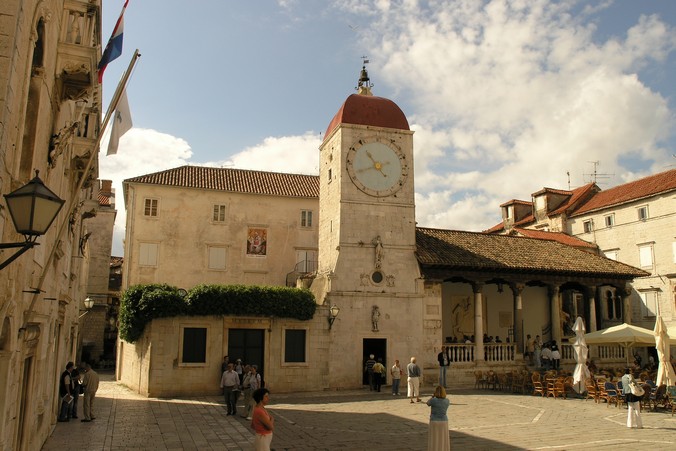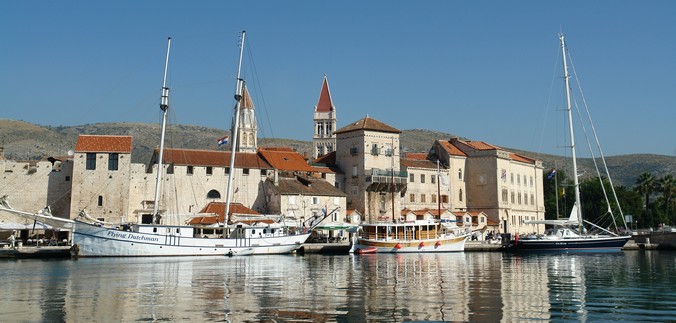You are here: ![]() > Trogir-en
> History
> Trogir-en
> History
HISTORY OF TROGIR
Trogir is an amphibian city, so old that its foundations - Illyrian, Hellenistic and Roman, under the current medieval versions – literally grow up out of Adriatic. The space of the prehistoric settlement was more or less the same as that of historical Tragurion, which was an island, or an island connected to the mainland with a narrow isthmus. Find go back 2000 BC. After 219 BC (the end of the Second Illyrian War) it become an important entrepot port of the Issa or Vis community. A Greek inscription incorporporated into the courtyard of the Benedictine nuns alongside the south door mentions the magistrates of the parent colony of Issa that governed the fillial colonies on the land. The grid of streets and residential blocks (insulae with a ratio of 1:2,5) of the central part of the city show all the perpendicularity typical of Greek urban planning.
In the 1st century BC it is mentioned as oppidum civium Romanorum. In the small Cipiko palace on the main square a paving that once belonged to the agora/forum has been found. Around Trogir a centuriation unit separate from Salona ager has been preserved, showing the later limitation. This is connected with Pliny's report that Empror Claudius sent his veterans to the place called Siculi (today's Resnik by Trogir). The same writer says that Trogir was marmore notum – noted for its marble, a fine stone that because of the ease with which it would take modelling and the gold colour it got from polishing was found in all the more important decorative parts of Diocletian's Palace (the Gold Gate, the portals of imperial mausoleum and the temple of Jupiter), and also in Radovan's Portal and the sculptures of Dukno
Trogir survived the Avar-Slav assault and destruction through the first half of the 7th century with a few other Antique settlements on the mainland (Zadar, Split, Kotor), emancipating itself after destruction of Salona to become an independent civitas. The Croatian princes and kings occasionally stayed in Trogir, residing in nearby Bijaći. The most eloquent Trogir monument of that time is the little basilica of St Martin (or St Barbara) on the main cardo, behind the city loggia on the square.
After the downfall of independent Croatian state, Koloman of the Arpad dynasty was crowned king of Croatia in Biograd in 1102; a crucial role in his peaceful assumption of power in Croatia and the cities on the coast was played by Bishop of Trogir John (died in 1111), whom Trogir, for the many miracles hat he performed, was afterwards to celebrated as blessed and patron of the town. The Middle Ages was a time of genuine self-confidence and reference to the town's own historical line, of ancient roots of course. The comune signed a treaty of alliance with Ancona invoking the common ancient origins. Antiquity, as alter ego, is seen in the construction of Trogir Cathedral and the palaces in the town, just as much as it clearly refers to the bell tower in Split.
Trogir sopravvissuto la distruzione degli Avari fino alla prima metà del settimo secolo con pochi altri insediamenti antichi del continente (Zara, Spalato, Cattaro), emanciparsi se stesso dopo la distruzione di Salona di diventarsi una civita indipendente. I principi e re croati occasionalmente sono stati a Trogir, nelle vicinanze residente a Bijaći.
Il piu`famoso monumento in Trogir di quel tempo era la piccola basilica di San Martino (o di Santa Barbara) situata sul cardo principale, dietro la loggia, sulla piazza principale. Dopo la caduta di stato croato indipendente, Koloman della dinastia degli Arpad fu incoronato re di Croazia a Biograd nel 1102, un ruolo cruciale nella sua assunzione pacifica in Croazia è stato interpretato da Vescovo Giovanni di Trogir (morto nel 1111), che Trogir, per i molti miracoli ha eseguito è stata poi a festeggiato come benedetto e patrono della città.
In the Middle Ages, the people of Trogir chose as their retors feudal magnates of the Croats, mainly from the mighty clan of the Šubić family. After the Treaty of Zadar in 1358 the city was an important point on the Angevin meridian that ran from Naples via Hungary to the Baltic. In June 1420 the Venetian fleet took Trogir, one of the last cities that had not wanted to surrender to Venice after it had in 1409 bought Dalmatia from Ladislav of Naples for 100,000 ducats. A bombardment lasted for serveral days, and there were many dead, many demolished houses and places, damaged towers, damaged walls. One of the first acts of the new Venetian Major Council in Trogir related to the ban of the official use of the Croatian language, on May 22, 1426. The Council ordered that no language but Italian or Latin could be spoken in the city. On the other hand, it was in Venetian Dalmatia that Croatian vernacular Renaisance literature was born at that time, which in Dalmatia itself was considerably more important than the written in the Italian. Not by chance, it is precisely in Trogir, that the most important anthology of Croatian writings of the 15th and 16th century has been preserved: the manuscript compilation of Petar Lucić called Vartal (Garden) made for the use of the nuns of convent St Nicholas. A genuine Humanist republic was formed in the town in the Renaissance with a whole galaxy of names, among which that of Koriolan Cipiko stands out. Not far from the city, for the safety of his serfs and for his own pleasing country life, he bulid a castello (Kaštel Stari), the first in a string around Trogir. Petar Cipiko, Koriolan's father, a collector of monuments and codices was „one of the first archeologists of Humanist Europe“ (T. Mommsen).
In the second half of the 13th and throughout the 14th century what was called Brogo-Varoš (Pasike) was bulid onto the oval ring of the Romanesque city, a refletion of the original geological form of the low islet on which Trogir is formed. At the time of the Angevins, the last quarter of the 14th century, Varoš was grit with walls and fortified with towers. In the mid-15th century the construction of the great castello called Karmelengo on the south west corner was completed. A particulary intersting approach was the making of a road via which, from the mainland, over a bridge, through the space between walls of the Renaissance bulwark and the other city ramparts it was possible to cross over the bridge to the island of Čiovo without entering the town, around the eastern part of it. In 1646, the old bridge to the mainland was knocked down and a new moving bridge was built, the barbicans were reinforced, board platforms and Baroque bastions to the north were built. During the period of French rule at the beginning of the 19th century they started a „sanitary demolition“ of the city walls, this was continued during the time of Austrian rule, which was particulary aimed at regulating the Foša (earlier, a much wider channel between city and mainland) because of the sedimentation of mud.
There were a number of city gates in the walls. Over the northern land gate is a statue of the Blessed John. The southern, maritime gate, in a Mannerist style, is the work of workshop of the Bokanićes. The original wooden door studded with huge nails is preserved. By it is loggia that was used for those who were late after the evening closing of the gate (and afterwards, for a fish market). Also still to be found in the medival city wall onto the south are the Vitturi Tower, part of the Benedictine convent of St Nicholas, and St Nicholas' Tower, west of the maritime gate.




















